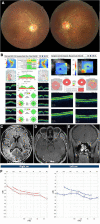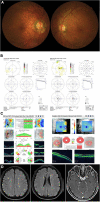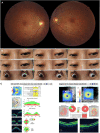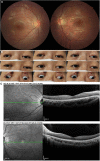Varying Clinical Phenotypes of Mitochondrial DNA T12811C Mutation: A Case Series Report
- PMID: 35860740
- PMCID: PMC9291510
- DOI: 10.3389/fmed.2022.912103
Varying Clinical Phenotypes of Mitochondrial DNA T12811C Mutation: A Case Series Report
Abstract
The T12811C mitochondrial DNA (mtDNA) mutation has been reported in Leber hereditary optic neuropathy (LHON) previously, with vision loss as the main manifestation. The involvement of other organ systems, including the central and peripheral nervous system, heart, and extraocular muscles, has not been well described. This case series report investigated four patients with T12811C mtDNA mutation, verified through a next generation sequencing. Two male patients presented with bilateral subacute visual decrease combined with involvement of multiple organ systems: leukoencephalopathy, hypertrophic cardiomyopathy, neurosensory deafness, spinal cord lesion and peripheral neuropathies. Two female patients presented with progressive ptosis and ophthalmoplegia, one of whom also manifested optic atrophy. This study found out that patients harboring T12811C mtDNA mutation manifested not only as vision loss, but also as a multi-system disorder affecting the nervous system, heart, and extraocular muscles.
Keywords: Leber hereditary optic neuropathy; mitochondrial DNA; mitochondrial disorder; ophthalmoplegia; optic atrophy.
Copyright © 2022 Xu, Sun, Feng, Chen, Sun, Chen and Tian.
Conflict of interest statement
The authors declare that the research was conducted in the absence of any commercial or financial relationships that could be construed as a potential conflict of interest.
Figures





Similar articles
-
Mutation Screening of mtDNA Combined Targeted Exon Sequencing in a Cohort With Suspected Hereditary Optic Neuropathy.Transl Vis Sci Technol. 2020 Jul 8;9(8):11. doi: 10.1167/tvst.9.8.11. eCollection 2020 Jul. Transl Vis Sci Technol. 2020. PMID: 32855858 Free PMC article.
-
Subclinical Leber's hereditary optic neuropathy with pediatric acute spinal cord onset: more than meets the eye.BMC Neurol. 2018 Dec 27;18(1):220. doi: 10.1186/s12883-018-1227-9. BMC Neurol. 2018. PMID: 30591017 Free PMC article.
-
Leber's hereditary optic neuropathy, intellectual disability and epilepsy presenting with variable penetrance associated to the m.3460G >A mutation and a heteroplasmic expansion of the microsatellite in MTRNR1 gene - case report.BMC Med Genet. 2018 Jul 27;19(1):129. doi: 10.1186/s12881-018-0644-3. BMC Med Genet. 2018. PMID: 30053855 Free PMC article.
-
A Typical Case Presentation with Spontaneous Visual Recovery in Patient Diagnosed with Leber Hereditary Optic Neuropathy due to Rare Point Mutation in MT-ND4 Gene (m.11253T>C) and Literature Review.Medicina (Kaunas). 2021 Feb 26;57(3):202. doi: 10.3390/medicina57030202. Medicina (Kaunas). 2021. PMID: 33652663 Free PMC article. Review.
-
Leber hereditary optic neuropathy.J Med Genet. 2002 Mar;39(3):162-9. doi: 10.1136/jmg.39.3.162. J Med Genet. 2002. PMID: 11897814 Free PMC article. Review.
Cited by
-
A Consolidated Understanding of the Contribution of Redox Dysregulation in the Development of Hearing Impairment.Antioxidants (Basel). 2024 May 13;13(5):598. doi: 10.3390/antiox13050598. Antioxidants (Basel). 2024. PMID: 38790703 Free PMC article. Review.
References
-
- Newman NJ, Wallace DC. Mitochondria and Leber’s hereditary optic neuropathy. Am J Ophthalmol. (1990) 109:726–30. - PubMed
Publication types
LinkOut - more resources
Full Text Sources

